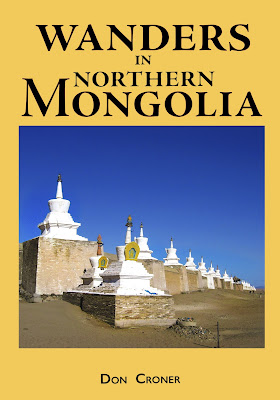Excerpts from Wanders in Northern Mongolia:
Zagastai Pass is also of some geographical interest, marking as it does the Continental Divide of Inner Asia. Little Khatarch Creek, which we had followed toward the pass, flows into a river system draining westward into one of the salt lakes of the Great Lakes Depression, none of which have an outlet to the ocean. On the north side of the pass begins Zagastai Creek which flows into the river systems eventually draining into the Arctic Ocean thousands of miles to the north. To find the source of the greatest of these river systems, the Yenisei-Angara-Selenge-Ider, is of course the raison d’être of this trip.
from Part 1, The Source of the Ider
The little boy born here in 1635 on the steppe of this broad valley bottom would later be named the Bogd Gegeen at Shireet Tsagaan Nuur; he would travel to Tibet and study with the Dalai Lama and the Panchen Lama; he would become the most revered leader in all of Khalkh Mongolia, founding many monasteries and creating great works of art; he would spend over a decade of his life in the Chinese capital of Beijing as a guest of the great Kangxi emperor of the Qing Dynasty, and his fame as miracle worker would spread throughout China; he would eventually die in Beijing and later the magnificent monastery of Amarbayasgalant would be built in his honor and serve as the final resting place of his remains; and in 1937 those remains would be destroyed in a bonfire by Mongolian and Soviet soldiers under the orders of a communist government goaded on by Joseph Stalin.
from Part 11, In Search of Zanabazar
According to the thirteenth-century chronicle entitled The Secret History of the Mongols the people now known as Mongols first appeared at the headwaters of the Onon River just north of a mountain called Burkhan Khaldun in the latter half of the eighth century. These people, then still just one tribe among the many which inhabited what is now Mongolia, soon expanded into the valleys of the nearly Kherlen and Tuul rivers. The upper basins of these three rivers—the Onon, the Kherlen, and the Tuul—make up the so-called Three Rivers Region considered to be the traditional homeland of the Mongols. Also, the mountain known as Burkhan Khaldun, located between the headwaters of the Onon and Kherlen, figured in several episodes recounted in the Secret History and was the scene of a crucial event in the life of Chingis Khan himself. As a result he worshipped this mountain, and he gave specific instructions that it should be honored by his descendants’ descendants forever. As I would learn, modern-day Mongolians have not forgotten this injunction.
from Part 111, The Birthplace of the Mongols




No comments:
Post a Comment